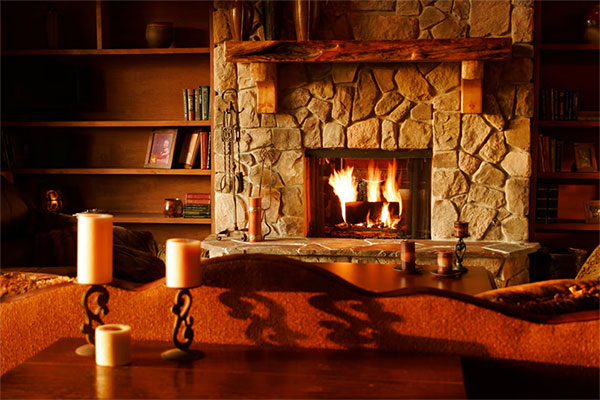Woodburning Fireplace FAQs
Dec 10th 2024

Why Should I Invest in a Wood Burning Fireplace?
What Types of Wood Fireplaces Are There?
What Is the Difference between Regular Combustion and Catalytic Burning
Are There Other Wood Burning Technologies?
Can I Install a Fireplace or Insert Myself?
How Often Do I Need to Clean My Wood Fireplace?
Which Firewood Should I Use For My Fireplace?
The ambient glow and warmth of the wood fireplace can undoubtedly warm up even the coldest nights. Though gas fireplaces got better over time, there is no denying that no other type of fireplace offers that comforting typical winter atmosphere as the wood-burning fireplace.
The centuries-old tradition of burning wood developed significantly over time. The wood-burning fireplaces and stoves still keep the authenticity of those from the past but function more safely and efficiently. The fireplaces we have nowadays keep us warm and comfortable, but they also reduce our heating costs. Besides that, unlike fossil fuels, wood is considered as renewable energy fuel.
If you want to install a wood fireplace, you may wonder about the type of fireplace, type of wood, or ways of maintaining the fireplace. We are here to answer some of those and many other questions. Feel free to contact us if you don't find the answer to your inquiry in our frequently asked questions.
Why Should I Invest in a Wood Burning Fireplace?
There are plenty of reasons to invest in a fireplace. A fireplace and the chimney contribute to the warmth and thus add value to the house. The hearth and the mantelpiece make a breathtaking point in the interior design. Besides, wood is the most environmentally friendly fuel, as it doesn't leave a carbon footprint. Fireplaces and stoves fueled by wood are exceptionally efficient, too. Without a doubt, one of the reasons why wood fireplaces are so popular is that it offers a cozy, romantic, and cheerful atmosphere.
What Types of Wood Fireplaces Are There?
When looking for the right fireplace, you may come across new terminology about your woodburning fireplace options, which can be confusing. There are four types of wood-burning fireplaces: open masonry fireplaces, wood fireplace inserts, wood stoves, and standard wood fireplaces.
- When talking about woodburning, many people think of an open masonry fireplace. These are usually open and made with brick, stone, or masonry. They are common in old houses.
- Wood fireplace inserts are closed fireboxes placed in unused open masonry fireplaces. Many people opt for them because they use the existing frame and chimney, which reduces the cost of installation.
- Stoves are freestanding fireplaces that can usually heat the entire household even when the outside temperature is way below 32 degrees Fahrenheit.
Finally, a wood fireplace is a firebox built into the wall. The difference compared to open masonry systems is that they don't require a chimney since they use venting like stoves and inserts.
What Is the Difference between Regular Combustion and Catalytic Burning?
Regular combustion involves a process where the wood burns and emits the gases into the atmosphere through a chimney or venting system. It usually occurs in open wood fireplace models. Units that use catalytic burning technology come with a catalytic combustor. In this case, the gases and the particles are funneled through a catalyst. As a result, we have a secondary burn that contains fewer gases and particles.
Are There Other Wood Burning Methods?
Yes, there are two other burning technologies – non-catalytic and hybrid. In the first process, there isn't a catalytic combustor. Instead, hot air circulates through air tubes while mixing with particles and gases. Once the process is complete, re-ignition occurs and causes secondary burn released from toxic matter. Most of the EPA-certified woodburning fireplace options use this system. A few units use hybrid burning, which involves a catalytic and non-catalytic system at the same time to produce a triple burn.
Can I Install a Fireplace or Insert Myself?
If you have the skills and knowledge required for installation, you can. However, remember that you need to install it following specific building codes and the instruction manual. That said, we recommend that you call a professional contractor to help to install your fireplace.
How Often Do I Need to Clean My Wood Fireplace?
This question may be tougher than it sounds. The general recommendation is to inspect and clean the wood fireplace unit at least once a year. But, you should do it whenever you notice creosote glaze. Using a fireplace often will cause soot and creosote buildup. Therefore, if you use the fireplace during the entire year, you will have to clean it more often.
Which Firewood Should I Use For My Fireplace?
You can burn most types of natural wood in all of the woodburning fireplace options However, you need to know that two factors affect the burning process – density and dryness of the wood. Hardwoods, such as maple, oak, many fruit trees, and ash are denser, and thus burn longer and hotter than the softwoods. Additionally, make sure never to use insufficiently dried woods as they produce less heat and more smoke. The best is to use kiln-dried firewood as the kiln speeds up and brings the seasoning process to perfection.
Our wish at Fireside Appliance is to provide as much information as possible and deliver a smooth shopping experience to our customers. If you have more questions about any of the wood fireplace models, don't hesitate to contact our sales experts. In case you don't have time for a phone call, you can talk to us via Live Chat. We are always more than happy to support you.
